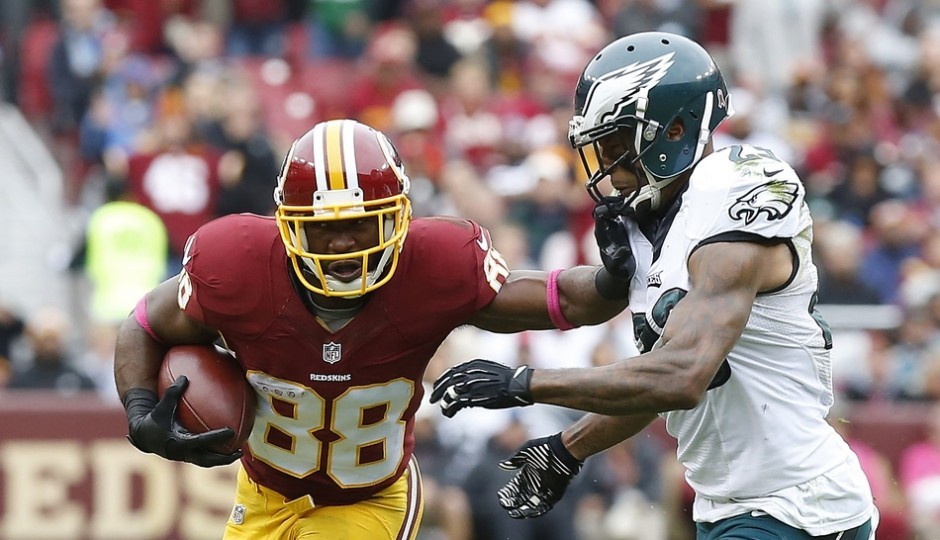All-22: Lessons From the First Washington Game

Pierre Garçon and Nolan Carroll. (USA Today Sports)
Eric Rowe is still kicking himself over a minor mistake he made 12 weeks ago. It was just the second NFL game he had appeared in on defense, and the first time he played more than 15 defensive snaps.
With just 26 seconds left in the Week 4 matchup, Kirk Cousins connected with Pierre Garçon to give Washington the 23-20 victory over Philadelphia. Nolan Carroll was the defensive back covering Garçon, but Rowe wasn’t far away.
“I have better technique now, but I could’ve had a lot better eyes,” Rowe said. “My eyes were all over the place, especially that last play where Pierre Garçon scored in the red zone. I could’ve jumped it earlier.
“I should’ve kept them on the receiver instead of in the backfield. When you look in the backfield and your total focus isn’t on the receiver, you’ll be late in reacting.”
When a team loses by three points in the final seconds of a game, players tend to focus even more on the details or singular plays. Caleb Sturgis missed a field goal and an extra point. Zach Ertz’s touchdown catch was nullified by an illegal formation penalty. Ryan Mathews fumbled the ball on Washington’s 37-yard line (although Nelson Agholor dropped the pitch).
But many of the lessons the players — and coaches — said they took from the last game come back to that 15-play, 90-yard game-winning drive.
One thing that hurt the Eagles on that series was a pair of runs that totaled 29 yards. The latter of the two was a 13-yard gain that gave Washington the ball in plus-territory.
“We have to read our keys and be responsible for our run fits. That’s all there is to it,” Brandon Graham said. “We beat ourselves last time on defense, like those late runs. It’s those self-inflicted wounds. And communication. We have to keep those communication lines open.”
The Eagles also struggled with play-action bootlegs. Washington converted several first downs using those, and Cousins often had wide open receivers after the play-fake.
“The lessons that we take from the first game is that we have to be really focused on the move passes,” DeMeco Ryans said. “They did a lot of quick throws, a lot of moving [Cousins around].”
One area that killed the Eagles’ defense — not just in Washington’s final series, but the whole game — was an inability to get off the field. Washington converted the majority of their third down attempts, partially because of the yardage they consistently picked up on first and second downs.
“They had a nice, you call them pick, screens, whatever you want to talk about, to beat man coverage, stacks,” Billy Davis said. “In the third-and-short window, I have to get out of that third-and-short window. You’re never going to be good on third down if you’re living in the third-and-five or less window that you’re defending.
“They had some good picks, screens, over the top, different things that attacked our man-to-man coverage. We’ll have to have some answers for it. Really after that game, some other people copied it and we played it well. We just have to do a better job on getting the third-and-longer.”
Washington utilized underneath crossing routes on those third-and-short situations. One example is Garçon’s 10-yard reception on third-and-3 when traffic in the middle of the field created separation between the receiver and cornerback. (The play, however, was called back because Garçon grabbed Carroll’s face mask after the catch.)
Washington also used a man-beater concept on third-and-3 in the first quarter to extend a drive they scored three points in. Cousins connected with Jordan Reed for the four-yard gain.
“He’s very athletic,” Chip Kelly said of Reed. “I think he has got a real good skill set in terms of how he runs routes. He’s almost like a receiver in terms of his ability to run routes, which is a compliment to him. It becomes a tough matchup because if you got three receivers on the field and him, you’re in 11 personnel, how do you match up with all those guys? I think he’s as tough a matchup as a tight end as there is in the league right now.”
Davis hit the nail on the head about the Eagles’ other opponents copying Washington’s schemes to beat Philadelphia’s man-to-man coverage. It’s something the defense has struggled with, particularly in the middle of the season, but they have improved some in that area.
However, it’s unclear why the Eagles don’t implement more zone coverage hand-offs when they encounter bunch formations. That’s a concept that worked particularly well against the Giants, including when Carroll scored on his pick-six.
Of course, there’s also the DeSean Jackson factor. Jackson, who didn’t play in the first matchup, has played very well lately. In his last five games, he’s combined for 429 yards and four touchdowns. He also has three receptions of at least 50 yards in that same stretch.
Jackson has consistently taken the top off of defenses, which has shifted attention away from Garçon and Reed. The tight end has especially benefitted, racking up more than 200 receiving yards and three touchdowns in his last two games combined.
“They’re playing as well as they’ve played all season,” Davis said. “DeSean is getting vertical balls at a high rate. He’s got the highest yards-per-catch. He’s DeSean. He blows the top off of everything. We’ve got to be aware and over the top of him and have a lot of concentration on him.”




